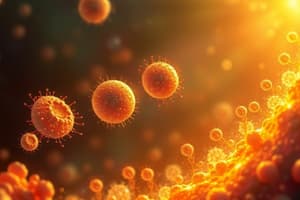Podcast
Questions and Answers
describe the components of DNA, and explain its functional relationship to RNA and protein.
describe the components of DNA, and explain its functional relationship to RNA and protein.
DNA is made up of sugars and phosphate groups forming a double helix structure. Nitrogenous bases (adenine, thymine, cytosine, and guanine) are attached to the sugars. The two strands are held together by hydrogen bonds between the bases (A-T and C-G). The sequence of these bases carries information for making RNA and proteins in a cell.
Why are mutation and recombination important in the process of natural selection and the evolution of organisms?
Why are mutation and recombination important in the process of natural selection and the evolution of organisms?
Mutation and recombination provide genetic diversity. Environmental factors determine which organisms survive based on their traits. This survival process is called natural selection. Genetic diversity is crucial for some organisms to adapt and survive. Those that survive may undergo more changes, leading to the evolution of the specie
Compare and contrast:
- cDNA and gene
- RFLP and gene
- DNA probe and gene
- DNA polymerase and DNA ligase
- rDNA and cDNA
- genome and proteome
Compare and contrast:
- cDNA and gene
- RFLP and gene
- DNA probe and gene
- DNA polymerase and DNA ligase
- rDNA and cDNA
- genome and proteome
- Both are DNA 2. Both are DNA 3. Both are DNA 4. Both are enzymes 5. Both are DNA 6.The proteome is the expression of the genome.
What is the purpose of culture media?
What is the purpose of culture media?
Why does the treatment of a wound with hydrogen peroxide result in bubbling?
Why does the treatment of a wound with hydrogen peroxide result in bubbling?
Which selective and differential medium is used to identify Staphylococcus aureus?
Which selective and differential medium is used to identify Staphylococcus aureus?
E. coli was incubated with aeration in a nutrient medium containing two carbon sources, and the following growth curve was made from this culture.
-E.coli is placed into one dish with different types of ingredients in that one dish
-The graph shows the growth of the microbes
a. Explain what happens at the time marked x.
b. Which substrate provided “better” growth conditions for the bacteria? How can you tell?
E. coli was incubated with aeration in a nutrient medium containing two carbon sources, and the following growth curve was made from this culture. -E.coli is placed into one dish with different types of ingredients in that one dish -The graph shows the growth of the microbes a. Explain what happens at the time marked x. b. Which substrate provided “better” growth conditions for the bacteria? How can you tell?
Clostridium and Streptococcus are both catalase-negative. Streptococcus grows by fermentation. Why is Clostridium killed by oxygen, whereas Streptococcus is not?
Clostridium and Streptococcus are both catalase-negative. Streptococcus grows by fermentation. Why is Clostridium killed by oxygen, whereas Streptococcus is not?
Most laboratory media contain a fermentable carbohydrate and peptone because the majority of bacteria require carbon, nitrogen, and energy sources in these forms. How are these three needs met by glucose–minimal salts medium?
Most laboratory media contain a fermentable carbohydrate and peptone because the majority of bacteria require carbon, nitrogen, and energy sources in these forms. How are these three needs met by glucose–minimal salts medium?
Flask A contains yeast cells in glucose–minimal salts broth incubated at 30°C with aeration. Flask B contains yeast cells in glucose–minimal salts broth incubated at 30°C in an anaerobic jar. The yeasts are facultative anaerobes.
a. Which culture produced more ATP?
b. Which culture produced more alcohol?
c. Which culture had the shorter generation time?
d. Which culture had the greater cell mass?
e. Which culture had the higher absorbance?
Flask A contains yeast cells in glucose–minimal salts broth incubated at 30°C with aeration. Flask B contains yeast cells in glucose–minimal salts broth incubated at 30°C in an anaerobic jar. The yeasts are facultative anaerobes.
a. Which culture produced more ATP? b. Which culture produced more alcohol? c. Which culture had the shorter generation time? d. Which culture had the greater cell mass? e. Which culture had the higher absorbance?
Flashcards
Components of DNA
Components of DNA
DNA is composed of sugar-phosphate backbones and nitrogenous bases (adenine, thymine, cytosine, and guanine).
DNA's relationship to RNA and protein
DNA's relationship to RNA and protein
DNA's base sequence dictates the production of RNA, which in turn directs protein synthesis.
Mutation and recombination's role in evolution
Mutation and recombination's role in evolution
Mutations and recombination create genetic diversity, enabling organisms to adapt to changing environments during natural selection, thus driving evolution.
Culture media purpose
Culture media purpose
Signup and view all the flashcards
Hydrogen peroxide bubbling in wounds
Hydrogen peroxide bubbling in wounds
Signup and view all the flashcards
Medium for Staphylococcus aureus identification
Medium for Staphylococcus aureus identification
Signup and view all the flashcards
E. coli growth curve and substrates
E. coli growth curve and substrates
Signup and view all the flashcards
Clostridium vs. Streptococcus oxygen tolerance
Clostridium vs. Streptococcus oxygen tolerance
Signup and view all the flashcards
Glucose-minimal salts medium
Glucose-minimal salts medium
Signup and view all the flashcards
Yeast ATP production (aeration)
Yeast ATP production (aeration)
Signup and view all the flashcards



